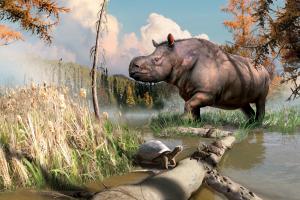
According to a study published today by the journal American Museum Novitates, fossils found near Whitehorse in the 1970s indicate rhinoceroses and turtles inhabited Yukon approximately eight million years ago.
Co-authored by a team of international researchers, including Yukon paleontologist Dr. Grant Zazula and Kristen Kennedy of the Yukon Geological Survey, the study examined previously unidentified tooth fragments in Yukon’s fossil collection. Based on the “dental fingerprint” seen in the enamel under a scanning electron microscope, the team believes they belong to an ancient relative of today’s rhinoceroses.
If so, the fossils represent the first evidence confirming the presence of mammals in this part of the world prior to the ice age. It also supports the model that animals such as these dispersed from North America to Asia via the Beringia land bridge.
Discovered in 1973 in the vicinity of the old Whitehorse Copper Mine near Wolf Creek, the tooth fragments were found alongside fossils from a pond turtle, a tortoise and an ancient pike. Based on the geology of the site, the fossils are believed to date to the late Miocene Epoch, about eight million years ago, and indicate a very mild climate, with warmer temperatures and wetter conditions.
Yukon’s abundant fossil record and world-class paleontology and archaeology teams continue to draw international attention. This study is another great example of how collaboration can lead to fascinating discoveries.
Minister of Tourism and Culture Jeanie Dendys
The new findings are the subject of an article titled: The first Tertiary fossils of mammals, turtles, and fish from Canada’s Yukon. The article was recently published in American Museum Novitates, a peer-reviewed academic journal published by the American Museum of Natural History.
The tooth fragments represent the only known record of the Rhinocerotidae in North America’s western Arctic, and support the theory that rhinos dispersed between Asia and North America across Beringia.
Tooth enamel is the hardest and most resistant material produced by a vertebrate and can be used to provide phylogenetic and taxonomic information.
The fossils were found in 1973 by Joan Hodgins while hiking with a youth group in the vicinity of the old Whitehorse Copper Mine near Wolf Creek.
Stewart Burnett
Cabinet Communications
867-332-0480
stewart.burnett@gov.yk.ca
Cameron Webber
Communications, Tourism and Culture
867-332-0400
cameron.webber@gov.yk.ca